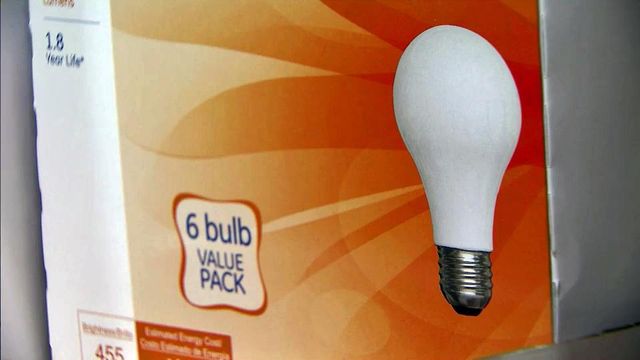New law turns out the light on traditional bulbs
Government regulations taking effect Wednesday mean the U.S. will no longer manufacture or import incandescent light bulbs.
Posted — UpdatedGovernment regulations taking effect Wednesday stop businesses in the United States from manufacturing or importing 60- and 40-watt incandescent light bulbs. It's all part of a 2007 federal law requiring light bulbs to meet higher energy efficiency standards. In the past few years, 75-watt and 100-watt bulbs were phased out.
At the Home Depot in Cary on Wednesday, manager Jonathan Pritchett said he only had about two weeks' worth left. He said the store saw a spike in sales of the bulbs last week.
Incandescent bulbs burn through a lot of electricity. For the average household, they make up about 20 percent of the power bill.
Greener options of LED and CFL (Compact Florescent Light) bulbs use much less power than regular bulbs and last longer. Replacing 36 standard bulbs with CFLs or LEDS would lower your power bill by more than $200 a year, according to GE.
Home Depot shopper Dan Wood has already made the switch to the greener bulbs and seen his electricity bills go down.
Shopper Shea Shelton doesn't think the idea is that bright.
"Requiring people to go to those new bulbs is ridiculous," Shelton said.
Calvin McEachin likes CFLs, but he doesn't like the warm-up time when he turns them on.
"They put out a lot of good light. The only thing I hate about it is when...you first put them on, it takes a while to get bright. So, you flip your switch (and) it's still dim," McEachin said.
"The daylight is the one that's like the blue tone. So, if you go with a cool white, you're going to be fine, or a warm white. Those are the colors if you're looking for that traditional color of an incandescent bulb," he said.
Consumer Reports has said that LEDs last the longest, but they are also the more expensive option to replace incandescent bulbs. However, rebates are making them more affordable. CFLs don't last quite as long as LEDs, but they are still a more efficient option and can use up to 70 percent less power.
Some LEDs can cost up to $25, but according to Consumer Reports, the price is worth it in the long run because the bulbs can last a decade and will save the consumer hundreds of dollars. CFLs can save $100 or more over the lifetime of the bulb.
• Credits
Copyright 2024 by Capitol Broadcasting Company. All rights reserved. This material may not be published, broadcast, rewritten or redistributed.






